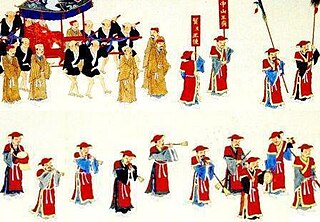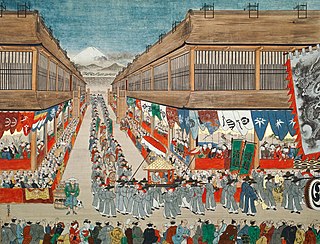- ↑ Walraven, Boudewijn et al. (2007). Korea in the middle: Korean studies and area studies, p. 361.
- ↑ Walker, Brett L. "Foreign Affairs and Frontiers in Early Modern Japan: A Historiographical Essay", Early Modern Japan. Fall 2002, pp. 48.
- ↑ Lewis, James Bryant. (2003). Frontier contact between Chosŏn Korea and Tokugawa Japan, pp. 21–24.
- ↑ Walraven, p. 359.
Related Research Articles

Over the course of Japan's Edo period, the Ryūkyū Kingdom sent eighteen missions to Edo, the capital of Tokugawa Japan. The unique pattern of these diplomatic exchanges evolved from models established by the Chinese, but without denoting any predetermined relationship to China or to the Chinese world order. The Kingdom became a vassal to the Japanese feudal domain (han) of Satsuma following Satsuma's 1609 invasion of Ryūkyū, and as such were expected to pay tribute to the shogunate; the missions also served as a great source of prestige for Satsuma, the only han to claim any foreign polity, let alone a kingdom, as its vassal.

The Joseon Tongsinsa (Korean: 조선통신사) were goodwill missions sent intermittently, at the request of the resident Japanese authority, by Joseon dynasty Korea to Japan. The Korean noun identifies a specific type of diplomatic delegation and its chief envoys. From the Joseon diplomatic perspective, the formal description of a mission as a tongsinsa signified that relations were largely "normalized," as opposed to missions that were not called tongsinsa.

Jo Eom was a Korean civil minister (munsin) in the 18th century during the late Joseon Dynasty.
Yun Sunji was a Korean scholar-official of the Joseon period in the 17th century.
Im Gwang was a Korean scholar-official of the Joseon period.
Jeong Rip (1574–1629) was a scholar-official of the Joseon Dynasty Korea.
O Yun-gyeom (1559–1636) was a Korean scholar-official and Chief State Councillor of the Joseon period.
Hong Gye-hui was a Korean scholar-official of the Joseon period in the 18th century.
Yeo U-gil was a Korean scholar-official of the Joseon period.
Yun Jiwan (1635–1718) was a Korean scholar-official of the Joseon period in the 17th and 18th centuries.

Jo Hyeong was a Korean scholar-official of the Joseon period, in the 17th century.

Jo Tae-eok, also known as Cho T'aeŏk, was an 18th-century Korean scholar-official and Jwauijeong of the Joseon period.
Hong Chi-jung (1667–1732) was a scholar-official and Prime Minister of the Joseon Dynasty Korea in the 18th century from 1729 to 1732.
Song Hui-gyeong was a Korean scholar-official of the Joseon period in the 15th century.
Pak Ton-ji was a Korean scholar-bureaucrat, diplomat, and ambassador, representing Joseon interests in the tongsinsa to the Ashikaga shogunate in Japan. He lived from the late Goryeo until the early Joseon periods.

Joseon missions to Japan represent a crucial aspect of the international relations of mutual Joseon-Japanese contacts and communication. In sum, these serial diplomatic ventures illustrate the persistence of Joseon's kyorin diplomacy from 1392 to 1910.
Pak Hŭi-chung was a scholar-official of the Joseon Dynasty Korea in 14th and 15th centuries.
Hwang Sin was a Korean officer of the Joseon period; in the 16th and 17th centuries. In 1588, Hwang placed first in the final civil service examination (Mungwa).
Joseon diplomacy was the foreign policy of the Joseon dynasty of Korea from 1392 through 1910; and its theoretical and functional foundations were rooted in Neo-Confucian scholar-bureaucrats, institutions and philosophy.

Yun Jeung or Yun Chŭng was a Confucian scholar in Korea during the late period of the Joseon dynasty. He was known as being a progressive thinker and for his opposition to the formalism and ritualism in the predominant philosophy of Chu Hsi. Yun Chung refused government office because he thought the Korean monarchy was corrupt, and spend his life teaching Sirhak ideas. He is known for the quote, "The king could exist without the people, but the people could not exist without the king."
References
- Daehwan, Noh. "The Eclectic Development of Neo-Confucianism and Statecraft from the 18th to the 19th Century", Korea Journal (Winter 2003).
- Lewis, James Bryant. (2003). Frontier contact between chosŏn Korea and Tokugawa Japan. London: Routledge. ISBN 978-0-700-71301-1
- Walker, Brett L. "Foreign Affairs and Frontiers in Early Modern Japan: A Historiographical Essay", Early Modern Japan. Fall, 2002, pp. 44–62, 124–128.
- Walraven, Boudewijn and Remco E. Breuker. (2007). Korea in the middle: Korean studies and area studies; Essays in Honour of Boudewijn Walraven. Leiden: CNWS Publications. ISBN 90-5789-153-0; OCLC 181625480
External links
Kim Igyo 김이교 | |
|---|---|
 Japanese painting of Kim, ca. 1811 | |
| Right State Councillor | |
| In office 3 March 1831 –25 August 1832 |